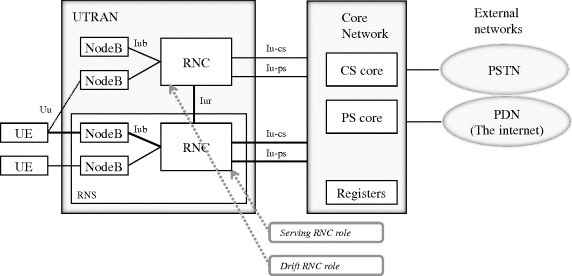3.3 3G
With 3G, there are equally many evolution steps. For mobile backhaul, the most important ones are:
- MSC server based core network architecture in 3GPP Rel-4
- IP transport in 3GPP Rel-5
- HSDPA in 3GPP Rel-5
- HSUPA in 3GPP Rel-6
- One tunnel in 3GPP Rel-7
- 64QAM (Quadrature Amplitude Modulation) (HSDPA), 16QAM (HSUPA) in 3GPP Rel-7
- 64QAM and MIMO (Multiple Input Multiple Output) combination (HSDPA) in 3GPP Rel-8
- Dual-cell and MIMO combination (HSDPA) in 3GPP Rel-9
- Dual-cell (HSUPA) in 3GPP Rel-9
- 4-carrier HSDPA in 3GPP Rel-10
- (Potentially) 8-carrier HSDPA in 3GPP Rel-11 (Rel-11 ongoing)
The above translates to (theoretical maximum) downlink peak rates for a single user so that with Rel-7, HSDPA 64 QAM reaches 21 Mbit/s. Rel-8, HSDPA 64 QAM with 2 × 2 MIMO achieves 42 Mbit/s. Rel-9, Dual-cell (2 × 5 MHz), MIMO and 64 QAM produces 84 Mbit/s. With a higher amount of carriers aggregated, the peak rate grows (four carriers 84 Mbit/s, and eight carriers potentially 168 Mbit/s). In practice, availability of terminals may limit the applicability. However, this illustrates that high peak rates are achievable with the enhanced HSPA+ networks.
Additionally, a number of improvements to existing functionalities have been included.
A simplified 3G system architecture with a UTRAN focus is shown in Figure 3.9.
Figure 3.9 3G system and UTRAN [37].

Each Node B connects to an RNC (Radio Network ...
Get Mobile Backhaul now with the O’Reilly learning platform.
O’Reilly members experience books, live events, courses curated by job role, and more from O’Reilly and nearly 200 top publishers.

